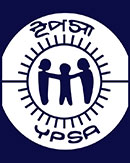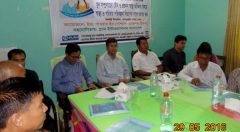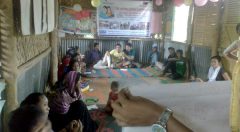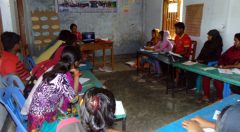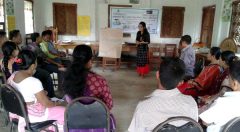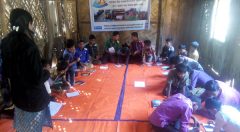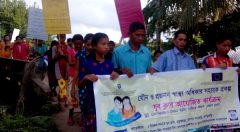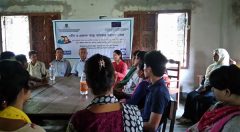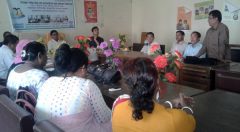Photo Gallery
Title of the project:
Creating an Enabling Environment for young people to claim and access their Sexual and Reproductive health Rights in Bangladesh (SRHR).
Duration of the project:
1st January 2015 to 30 June 2019.
Funded by: European Commission and Swedish SIDA
Supported by: Plan International Bangladesh
Implemented by: YPSA
Background:
The action will contribute towards the efforts of the Government of Bangladesh (GoB) to achieve the Millennium Development Goals (MDGs) and the Programme of Action of the International Conference on Population and Development (ICPD PoA Cairo 1994). This will be done through support to the implementation of GoBs National Plan of Action 2011-2016 (NAP) based on the National Adolescent Reproductive Strategy 2006 (NARS).
Plan and the partner Marie Stopes were actively involved in the development of NARS and NAP, as members of the national working committee led by Directorate General Family Planning (DGFP) and Ministry of Health and Family Welfare (MOFW). The action is aligned with NAP objectives and implementation strategies, and targets the weak capacity of local and district government to translate NARS into action, and low use of government services of youth3. The capacity of GoB officials at sub – distict (Upazilla) level to assure quality and monitoring of youth friendly services will be addressed4. District officials from Health, Education5, and other relevant departments from Ministry of Women and Children Affairs (MOWCA) and Ministry of Information (MIO) will be targeted to ensure support to Upazilla implementation. The action will develop models in close cooperation with government officials, primarily Ministry of Health as ‘goal owner’ of NARS, and critically evaluated for potential replication by government.
The overall objective is to contribute to improve the sexual and reproductive health status of all young people in Bangladesh, including socially excluded youth from hard the reach areas, through ensuring universal access to sexual and reproductive health services and information. This will be monitored against key MDG indicators; MDG5: maternal mortality, adolescent birth rate, contraceptive use and antenatal care coverage and MDG6A: HIV prevalence among youth and condom use at high risk sex and linked to monitoring and evaluation of NAP and NARS, and GoBs Maternal Mortality Study and the Demographic and Health Survey. The specific objective is to enable young people, 10-24 years old, to make informed decisions, access accurate information and quality services for sexual and reproductive health in Barguna, Khagrachari and Kishoreganj by 2018. In order to monitor the ability of young people to take action the rate of child marriages, adolescent birth rates, and prevalence of STIs, including HIV among the targeted age range in the target areas will be monitored. Data collection will as far as possible be aligned with the NAP, which will enable comparison with national data and data from other Districts.
Objective/goal:
To improve the sexual and reproductive health status of all young people in Bangladesh, including socially excluded youth from hard the reach areas, through ensuring universal access to sexual and reproductive health services and information.
Purpose of the project:
To enable young people, 10-24 years old, to make informed decisions, access accurate information and quality services for sexual and reproductive health in Khagrachari by 2018.
Working area: 05 Unions of Panchari Upazila, Khagrachari
Activities:
Activity 1.1 Capacity building of Master trainers and peer educators on peer education, Comprehensive Sexual Education (CSE) and Life Skill Education (LSE)
Activity 1.2 Form, activate and support peer youth groups with activities on CSE and LSE
Activity 1.3 Develop age appropriate Information Education Communication (IEC) materials
Activity 1.4 Provide Parenting training and outreach to marginalized groups to support SRH discussions with children and community
Activity 1.5 Work with teachers to facilitate Sexual Reproductive Health (SRH) discussions/teaching in the school environment
Activity 1.6 Raise awareness in community on SRH issues to support youth to access information and services
Activity 1.7 Mobilise young people for participation in youth clubs and youth forum
Activity 2.1 Half yearly Technical advisory group (TAG) meeting with relevant ministry officials and other development organizations working on Sexual Reproductive Health and Rights (SRHR)
Activity 2.2 Develop SRHR module for teachers training curriculum in a participatory way
Activity 2.3 Orient and support the key responsible groups for different actions under National Adolescent Policy (NAP) to implement and incorporate into their own action plan
Activity 2.4 Quality monitoring and supportive supervision visits by Local health officials
Activity 2.5 Joint Monitoring visit to field from national level
Activity 3.1 Map Civil Society Organization (CSO)s from local to national level.
Activity 3.2 Identify and regularly coordinate with relevant CSOs in target areas
Activity 3.3 Build linkages between CSOs, and youth clubs/forums
Activity 3.4 Facilitate annual Youth Forum event for National Advocacy
Activity 3.5 Capacity building for partners and CSOs, on SRH and long term sustainability
Activity 3.6 Support the development of monitoring and review mechanisms with the Community Clinic
Support Groups (CSG), Community Clinic Management Groups (CMG), Union Health (UH) Family Welfare
Committee (FWC) and Union Health and Education (UHE) standing committees.
Activity 4.1: Identify newly married young couple and link them to service providers
Activity 4.2 Identify and ensure registration of newly pregnant young women and link them to service providers
Activity 4.3: Provide age appropriate counselling services for young people (10-24 years)
Activity 4.4: Create/support a referral system to link to local available services
Activity 4.5: Youth Friendly Health Services (YFHS) training and follow up for service providers
